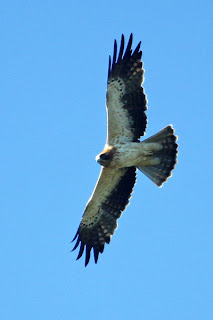The numbers of some bird species, Spoonbills and Black-tailed Godwits for instance, have now reduced quite noticeably as they have continued their migration to West Africa, encouraged no doubt by the drop in temperatures and a following wind from the north. However, the total number of birds remains high as thousands of gulls have arrived and there are Chiffchaffs wherever you look.
Black-tailed Godwit
Searching through the gulls isn’t everyone’s idea of fun but there are occasional rarities to be found and there are colour rings to be read. A Ring-billed Gull was seen at Sagres at few days ago and two Great Black-backed Gulls were found at Quarteira but here in the Eastern Algarve we have so far had to content ourselves with the regular six species. However, the numbers of Audouin’s and Slender-billed are now much lower and we have heard that Audouin’s colour-ringed this year in the colony in the Ria Formosa have been reported recently from The Gambia. A colour-ringed Mediterranean Gull from Italy has been our best find this week.
Audouin's Gulls
We’ve been twice in the past few days to Castro Marim where there is now much more water in the Cerro do Bufo saltpans than we would wish for. Notable sightings there have included as many as 200 Common Shelducks and close to 100 Black-necked Grebes. Common Shelduck is a species that bred for the first time in Portugal as recently as 2000 but seems to be doing remarkably well. Back in the summer we saw more than 100 young ones at a site near Faro but a winter flock of 200 is a record as far as we are concerned.
Common Shelduck
Black-necked Grebe
Waders can still be found in good numbers and variety around the Ria Formosa. In fact we have recorded 25 species locally in the last few days. For us, one of the attractions here is how close we can get to them and, of course, we enjoy trying to photograph them. Some are easier than others!
Little Stint
Other species that have proved popular with visitors recently have been Greater Flamingo, Bluethroat, Glossy Ibis, Little Bittern and Caspian Tern, all of which we expect but never tire of seeing and showing to people.
Caspian Tern
Less predictable are the hirundines, but at the moment we seem to be seeing Crag Martins just about everywhere (including from our window) and yesterday we saw Red-rumped Swallows.
The Algarve isn’t particularly noted for its birds of prey but in the last few days we have seen several Booted Eagles, an Osprey, Hen Harriers, Marsh Harriers, Common Buzzards, Common Kestrels, Black-winged Kites, a Merlin and an Egyptian Vulture. And we can add to these the Red Kites, Golden Eagle and Spanish Imperial Eagles that we saw during our day in the Castro Verde area of the Baixo Alentejo.
Booted Eagle
In the Alentejo, as well as the raptors, it was good to see Great Bustards in reasonable numbers and we managed to get quite near to a flock of 100 or more Common Cranes. On a particularly windy day we struggled to get good views of Calandra Larks or Black-bellied Sandgrouse but the Spanish Imperial Eagles made up for any disappointment; we watched three of them, all young birds, first on the ground and then all together in one tree. It might have been nice to see them through a telescope but not really necessary as they were close enough that if we had got out of the car they would undoubtedly have flown off.
November was good, December has started well and today the wind has dropped and the temperature has risen.












No comments:
Post a Comment